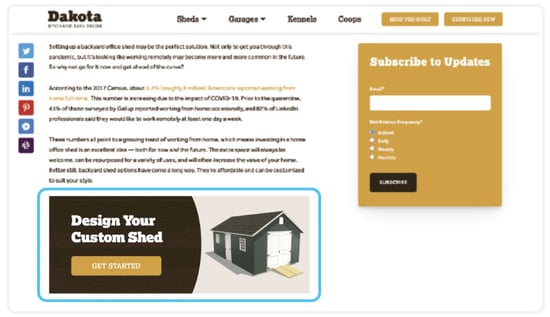Is your B2B digital marketing strategy set up for success?
We understand that when you create a B2B digital marketing strategy, there are a few important things to consider. After all, you’re not marketing to consumers — your product is probably not something everyone will use or consume daily. So, often that leaves B2B leaders asking themselves how do you make sure your B2B marketing strategies are going to be successful.
Over the years, we’ve worked with numerous B2B and manufacturing businesses to help create modern marketing plans that help their businesses grow on purpose. If you find yourself asking where do I go next to develop internet marketing strategies, or where do I even start? You’re not alone. We talk to business and marketing leaders about ways to take their marketing to the next level. In this post, we’ll cover a few tactics that will help ensure your success.
Goals & Metrics
You can't formulate a plan without knowing where you want to go. Defining trackable goals allows you to measure your efforts and success.
If you've been following other content from us, you'll know that we think goals are one of the best guides people can use. Let's face it; if you don't have clearly defined goals, you're driving around with no idea what destination you are trying to reach.
We've all used navigation apps to get us to a new place, so you know when you type in your destination, you often are given a couple of different route options from which to choose. For instance, you may want to take the route with the shortest mileage, or maybe you're more concerned about the shortest trip time. Either way, the point is there are often different paths that help you get to your goal. Marketing and sales strategies are no different.
Take the time upfront to make goals that align with your business, both where it is now and where you want to go. Then be sure you measure progress towards these goals. You will often see immediate results with some forms of digital marketing added to your B2B marketing strategies. Others will take a bit longer to work, but the beauty is those efforts are often more sustainable. These long-term or inbound marketing strategies are designed to grow over time, continuously building your funnel and providing predictable results.

I'll cover more on this later, but for now, check out the resources below that will help you create SMART goals for your business and leading metrics and sales goals that you can track and measure.
Resources:
- Marketing & Sales ROI Goals Worksheet
- Leading Indicator Metric Goals Calculator
- Sales Goals by Product Line Calculator
Articles:
- The Importance of Strategy in Digital Marketing for Manufacturers
- What is Digital Marketing for Manufacturers?
- 3 Steps To Creating A HubSpot Digital Marketing Strategy
- Are You On Track To Hit Your Business Growth Goals?
- What Is Digital Transformation & How It Will Impact Your Business
Get Started Defining Your Goals Today
Use our goal setting and marketing investment worksheet to create business goals that can be tracked and measured.
Niche Audiences
Your niche audience is your "who" — the trick is finding where they spend time online so you know the right places to market.
I assume most of you probably have some idea of your niche and what niche works for your business. This is based on who buys your products and what problems you solve for them. If you're unsure or need to revisit these groups, check out our persona guide for some additional guidance on defining this.
 |
 |
Here's where the real trick is: you have to figure out where they spend their time online. The key to successful B2B marketing strategies is marketing to audiences where they are. Start by brainstorming where they might be — industry sites, specific social media platforms, search engines, etc. If you can't figure it out, don't assume they're not online. Trust me. That's never true — they just need to be tacked down. Since there aren't as many niche markets, they're harder to find, but that doesn't mean they're not there. You have to get creative to find them.
Engagement
One of the best-kept secrets of digital marketing strategy is to engage your audience with content focused on their problems, not your business.
Once we find your audiences, we need to engage them. We need to provide them with great content that they find helpful, relevant, and engaging. What do they care about? How can we give value to them, so they think of you as the experts in the field and the solution to their problem?
So often, we just see companies promote themselves. They end up not talking about the customer and how they can help solve their problems outside of simply buying. And we understand, it’s easy to fall into this idea because you know the most about your product and your business. You tend to want to tell everyone about your great solutions, and you have the answer to their needs. These strategies aren’t always wrong; they can be good for buyers at the end of their journey. But, we want to make sure we’re capturing people earlier in the process.
Generally speaking, B2B companies have longer buying cycles. Customers spend more time researching purchases before they even contact a sales rep. And we don’t see this trend going away anytime soon. Here are some stats from the 2020 buyer report that validate these trends:
- 48% of buyers report being positively impacted by vendor ads they see while doing research
- 70% of buyers consider "content that speaks directly to their industry" as very important
- 76% of buyers note that their ultimate vendor selection and buying decision are "significantly impacted" by content
- 91% of buyers want "easy access to content without long forms"
- 92% of buyers say that their choice of vendor is influenced by "an extensive menu of thought-leadership content"
So what does all that mean for you? Well, we want to be the go-to place for people to do their research. We want to build your business up as the thought-leaders in the industry. If you can let your audience know you understand their problem and how your solutions can transform their business and lives, they will see the value.
Conversion Paths
Don't lose interested audiences due to a confusing or unclear conversion path — give them clear next steps.
This might seem obvious, but honestly, this is one of the biggest problems that we see with clients when starting out. How does someone convert on your site? Do you make it clear and simple for them to understand what they should say yes to or what their next step should be?
 You need to set up clear paths to get someone from A to B. Don't make them figure it out — because ultimately they won't; they'll just leave your website. The solution doesn't have to be complicated. It could be as simple as a call-to-action (CTA) on product pages that say "Request a Quote" or "Schedule a Call." Or maybe "Download Our Checklist" on a blog post. It's important to remember not every CTA should be a call to purchase. CTAs need to support the content, but visitors should know the next step if they're ready to buy. If they aren't prepared to buy, they should be able to find educational content that will nurture them in the right direction. The bottom line is: don't make your visitors work to convert. Make it easy and straightforward.
You need to set up clear paths to get someone from A to B. Don't make them figure it out — because ultimately they won't; they'll just leave your website. The solution doesn't have to be complicated. It could be as simple as a call-to-action (CTA) on product pages that say "Request a Quote" or "Schedule a Call." Or maybe "Download Our Checklist" on a blog post. It's important to remember not every CTA should be a call to purchase. CTAs need to support the content, but visitors should know the next step if they're ready to buy. If they aren't prepared to buy, they should be able to find educational content that will nurture them in the right direction. The bottom line is: don't make your visitors work to convert. Make it easy and straightforward.
Re-engagement
Don’t let yourself fall to the bottom of the pile. Use re-engagement tactics to stay top of mind with your audiences, so they choose you when it’s time.
One of the most overlooked tactics in B2B marketing strategies is re-engagement. You absolutely can not forget to re-engage prospects. Like we mentioned earlier, the buying cycle for B2B products can be lengthy. You need to continue to remind them you are the best solution up until the moment they’re ready to buy. This can be accomplished in many different ways. And what’s right for your company may not be best for another.
One method that we’ve found works pretty well is retargeting your visitors with banner ads. These can be general branded ads or specific to the product/service. These types of advertisements remind prospects of you and continue to build your brand recognition.
 Another great way to re-engage contacts is through email. Sending out communication to your prospects again via email can remind them of your company and give them a way back to your site. Continue to provide them with more valuable information to help research solutions.
Another great way to re-engage contacts is through email. Sending out communication to your prospects again via email can remind them of your company and give them a way back to your site. Continue to provide them with more valuable information to help research solutions.
Remember to keep your audiences re-engaging with your business, so you are a clear choice when the time comes.
Long-term and Short-term Tactics
Balancing long-term and short-term marketing tactics allows businesses to grow funnels and pipelines over time, providing more predictable results.
When working on a B2B digital marketing strategy plan, it's important to work in both long-term and short-term tactics. You'll find that some initiatives have quick results, but that success may go away. For instance, if you stop paying for them or you attend a tradeshow. While the long-term tactics may take a bit longer for you to see, the results generally have better longevity. We typically recommend a good mix of both — you can read more about why this is our recommendation in another article.
We look at it like having a balanced stock portfolio. If you have all your money in one type of investment, you're not balanced, so you will see fewer returns over time, ultimately creating more risk. The same goes for marketing. If you can move people from outbound marketing to inbound marketing funnels and improve conversion over time, this will ultimately result in your business growing on purpose and not just by chance.
Where to Go From Here
Once you have worked through all of these pieces and believe you have tactics that will support your goals, don’t forget to write down your plan and timeline. This helps ensure your strategy gets executed and goals are tracked.
Ready to create your marketing plan? We’ve created a digital marketing plan template to get you started.
For more insight on how to use a digital marketing plan and how to get started creating digital marketing strategies, check these additional posts:
Subscribe to Our Blog
Stay up to date with the latest marketing, sales, and service tips.





